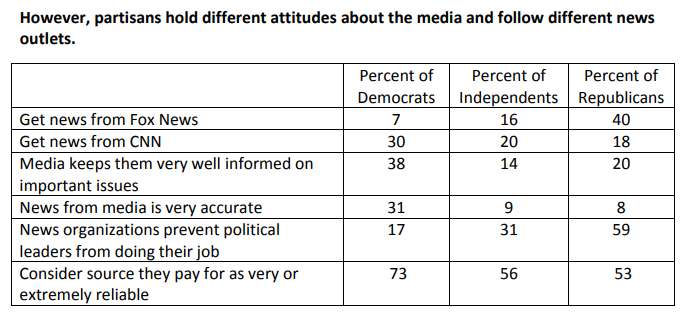Republicans and Democrats tend to follow news in similar ways

Republicans and Democrats are very much alike in the ways they follow the news despite their differing opinions of the media, according to a report released today by the Media Insight Project, a collaboration of the American Press Institute and The Associated Press-NORC Center for Public Affairs Research.
People on both ends of the political spectrum are equally likely to pay for news, to get news from social media, to seek news out actively rather than obtain it passively, and to get news multiple times a day. Democrats and Republicans are also equally likely to use local news sources, and they tend to follow similar topics, the report finds.
Yet, Republicans and even independents tend to be less satisfied than Democrats with the sources they use. Democrats, for instance, are more likely than Republicans or independents to say the news sources they use are reliable. Democrats are also more likely than Republicans or independents to say the news sources they pay for are a good value.
"Although Republicans and independents are more skeptical of the media than Democrats, people on either end of the political spectrum are consuming news in quite similar ways," said Tom Rosenstiel, executive director of the American Press Institute. "The political divisions facing the country present real challenges for the news industry as it tries to find a sustainable path forward. But the idea that Republicans and independents are consuming news entirely differently, or consuming entirely different news sources, isn't true."

Key findings from the report include:
- Democrats and Republicans follow a range of news topics at strikingly similar rates. They are equally likely to follow news about national politics (61 percent vs. 64 percent), local politics (15 percent vs. 13 percent), and their town or neighborhood (16 percent vs. 19 percent).
- There are few differences when it comes to technology use for news among Democrats, Republicans, and independents. They are about equally likely to get news from cell phones (86 percent, 84 percent, and 85 percent) and computers (66 percent, 65 percent, and 63 percent), while independents are a little less likely to get news from televisions (84 percent, 85 percent, and 78 percent).
- Democrats are more likely than Republicans and independents to trust information from the media a lot (30 percent, 8 percent, and 12 percent).
- Among those who pay for news, 73 percent of Democrats say their paid source is very or extremely reliable versus 56 percent of independents and 53 percent of Republicans.
- Independents are less likely than Democrats and Republicans to watch, read, hear, or see news at least several times a day (61 percent vs. 72 percent and 71 percent).
- Democrats who pay for news are more likely than Republicans who pay to say the source they subscribe to is a very good value (45 percent vs. 30 percent).
"The results indicate that people who identify themselves as Democrats versus Republicans share the same basic approach to and appetite for news," said Trevor Tompson, director of The AP-NORC Center. "The real differences in behavior are found between people who identify with one of the two major political parties and those who consider themselves independents or nonpartisans."
Provided by University of Chicago


















